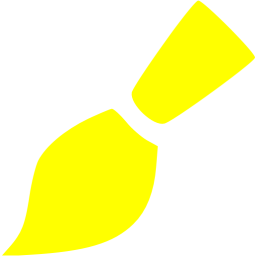

- Yellow paintbrush icon how to#
- Yellow paintbrush icon free#
You can see the surrounding top case has yellowed some, and the bottom case has yellowed a lot.Ī few years ago, some enterprising and chemistry-savvy forum users discovered that hydrogen peroxide could help remove these free bromides from the plastic, restoring the original white color. The cartridge slot shows the original SNES color. The Super Nintendo we’ll be using as our example today, seen below, has a much yellower base than top. Your Super Nintendo may be much yellower than your friend’s, just because they were from different batches of plastic. Here’s what’s even weirder: sometimes, two pieces of plastic in the same machine can be different levels of yellow. Modern plastics have improved the chemistry so this process doesn’t happen, but those old machines from the 80s aren’t so lucky.ĭifferent retro machines will yellow at different rates than others, even from the same line of products. When exposed to UV light, those bromine molecules can destabilize and leech through to the surface, causing the plastic to turn yellow (or even brown if left long enough). This yellowing happens thanks to a flame retardant called bromine in those old ABS plastics.
If you want a more opaque (solid) look, allow the first coat to dry and then repeat steps the two previous steps until you get the look you want.Why Old Plastic Turns Yellow (and How You Can Make It White Again). You don't want to completely wipe it off or you'll need a lot of coats. Using a rag or paper towel, gently wipe off the paint from the wood surface - again in the direction of the wood grain. Use long brushstrokes and only apply to a small section at a time. Starting with a very small amount of the whitewash mixture on a paintbrush, brush in the direction of the wood grain. To make the whitewash paint, dilute regular latex paint with some water (1 part water to 2 parts flat white paint). 

Allow the stain to dry for at least 24 hours before continuing. Otherwise, lightly sand the surface and stain the wood a medium brown or grayish color.
If your wood has previously been stained or sealed, you're good to go. Both may be used to achieve a similar look on brick but usually only whitewash is used on wood. Limewash is a limestone-based product made specifically for brick. Sometimes you will hear these terms used interchangeable but there is a definite difference. What's the Difference Between Limewashing and Whitewashing? I didn't want to cover up the grain and texture with a solid white paint, so I decided that whitewashing would be a good idea. Alternatively, a clear furniture wax will also help protect it. Polycrylic doesn't yellow over time and will protect the finish. Tip: If you are whitewashing a piece of furniture, finish off the project with a coat of matte polycrylic to protect it. If you want a more opaque (solid) look, allow the first coat to dry and then repeat steps the two previous steps until you get the look you want. Using a rag or paper towel, gently wipe off the paint - again in the direction of the wood grain. Wipe the excess off the paintbrush each time so that you're using more of a "dry brushing" technique. Starting with a very small amount of the whitewash mixture on a paintbrush (no rollers allowed!), brush in the direction of the wood grain. Allow the stain to dry for at least 24 hours before proceeding. Otherwise, start by staining the wood a medium brown or grayish color. If you're planning on staining before whitewashing, ensure the surface is smooth by lightly sanding it. The end result may look slightly different due to the differences in the wood species but you'll achieve a similar effect. Whether it's oak, pine or another variety doesn't matter. The whitewashing technique can be applied to stained or natural wood. Yellow paintbrush icon how to#
How to Whitewash - The Whitewashing Technique





 0 kommentar(er)
0 kommentar(er)
